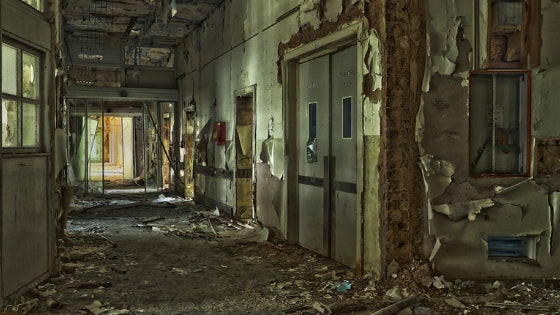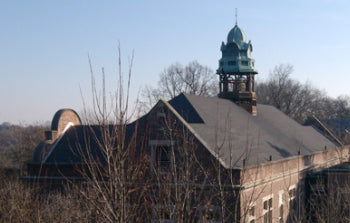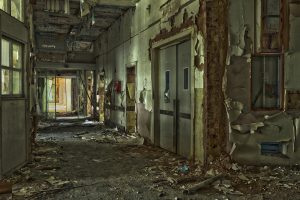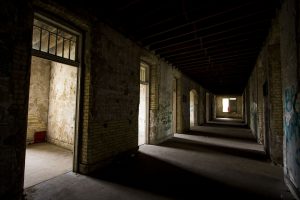History of Pennsylvannia’s Most Haunted Place: Pennhurst Asylum
December 18, 2018

Asylums have long been known to be sites of unimaginable suffering and abuse, and Pennsylvania’s Pennhurst Asylum is no different.
Previously known as the Eastern Pennsylvania State Institution for the Feeble-Minded and Epileptic, it was opened on November 23, 1908.
In its 79 years of operations, there were hundreds of allegations of abuse and neglect of patients, many of whom were mentally or physically disabled.
But the activity didn’t stop after its closure.
Many paranormal investigation teams have spent time on the 1400-acre property and have reported a plethora of activity, including apparitions, shadowy figures, odd temperatures, and moving objects.
But there are still unanswered questions.

History of the Pennhurst Asylum
According to paranormal researchers, Pennhurst Asylum is one of the most haunted places in Pennsylvania, if not the United States.
Ghost hunting has become a sort of cottage industry around the property, and there’s even a Pennhurst Paranormal Association.
Their tagline is “They lived here, died here, and are still here.”
But before we get into the haunted stuff, we have to talk a little bit about our setting.
Pennhurst Asylum itself is a beautiful, sprawling campus of about 20 buildings. The older buildings are red brick with granite and terra cotta trimmings, making them quite striking.
The facility was built to be almost entirely self-sufficient, with a power plant, farmland, and other facilities on the property.
For things that they could not provide for themselves, it was serviced by a private rail line that brought supplies from the outside world.
Many of the buildings are connected by underground fire-proof tunnels to make moving patients around easier, like many similar facilities of the era.
The buildings were designed with small rooms for 2 or 3 people, but within four years of its opening, Pennhurst was already overcrowded due to pressure to admit immigrants, orphans, and criminals.
Residents were classified into three categories: mental—imbecile or insane, physical—epileptic or healthy, and dental—good, poor, or treated.
In 1913, the Pennsylvania Legislature appointed a Commission for the Care of the Feeble-Minded, which stated that the disabled were “unfit for citizenship” and recommended a program of custodial care, meaning that Pennhurst would become even more overcrowded.
By the mid-60s, the asylum housed 2.791 people – 900 more than the facility could comfortably accommodate.
Most of these patients were children, and despite the facility’s label as a “school”, only 200 of the residents were in any kind of art, education, or recreational programs that could have helped improve their condition, though many were high-functioning enough to improve with such care.
The facility had only 9 medical doctors and 11 teachers on staff, none of whom had special education training.
Bullying was rampant and unpoliced, and it was thought that this was the real reason for the many “accidental” deaths and suicides that occurred.

In 1968, conditions at Pennhurst were finally revealed to the public in a five-part TV news report by a local correspondent for NBC10 named Bill Baldini – these segments were titled “Suffer the Little Children.”
This horrifying footage triggered a public outcry, but it would still take almost a decade of legal action against Pennhurst before the facility closed.
The allegations that finally led to a lawsuit against Pennhurst Asylum were those of Terri Lee Halderman, who, upon a visit to her parents, was found to have unexplained bruises.
Although the case was never expected to go very far, the courts would find that the conditions at Pennhurst were deplorable, violating the Fourteenth Amendment.
They also found that the institutions used cruel and unusual punishment, which violates both the Eighth and Fourteenth Amendments, as well as the Pennsylvania Mental Health and Retardation Act of 1966.
In 1983, nine employees were indicted on charges ranging from assaulting patients — some of whom were in wheelchairs, to arranging for patients to injure each other.
All of these findings led to the District Court’s decision to close the facility – this was the first time that this was ever done based on a constitutional right to community services, and the case would become an important precedent known as the Pennhurst Doctrine.
Shortly after its closure, the Department of Military Affairs acquired the upper campus and reopened it as the Southeastern Veteran’s Center.
In 2001, the state began acknowledging its duties to maintain historic property in relation to Pennhurst, and the Pennhurst Memorial and Preservation Alliance was formed to advocate for certain uses of the property.
As of 2010, the administration building has been renovated and repurposed as the Pennhurst Asylum Haunted House – despite controversy from locals and those previously affiliated with the asylum, the attraction has been successful.

Hauntings and Other Phenomena
Timothy Smith, the president and CEO of the PPA, is the son of the property’s current owner, and he believes that the high occurrence of paranormal activity at Pennhurst could make it very profitable.
The official research team for Pennhurst Asylum is the Shore Paranormal Research Society, a team of trained specialists whose purpose is to discover the truth behind claims of paranormal activity.
According to Jim Ansbach, the SPRS’s founder and case manager, Pennhurst Asylum is a hotspot for the paranormal.
They have conducted numerous large-scale investigations of the property, taking photos, video, and audio recordings in multiple undeveloped buildings, and reporting numerous sightings, mainly in the Quaker Building.
In the Quaker building, numerous shadowy figures appear to manifest and dissipate at will; these include what appears to be a young girl with long dark hair and a large, hunched figure with dangling arms.
Items have been seen moving while no one is near them, even going so far as to be propelled across the basement at times.
Investigators have reported physical interactions with spirits such as shoving and scratching; these assaults would leave physical marks that could be seen even after leaving the property.
There were also multiple electromagnetic frequency spikes recorded while in the building, despite there being no power currently supplied to it.
One of the most well-documented occurrences at Pennhurst is Electronic Voice Phenomena (EVP), which is recordings of voices that could not be heard at the time of recording.
Voices can be heard saying things like “go away” “we’re upset” and, disturbingly, “I’ll kill you”. Screaming and crying can also be heard without the help of recordings.
It appears that, despite the patients being gone, the sounds of Pennhurst Asylum remain.
The Pennhurst Paranormal Association plans to open the former hospital for more ghost hunts in the future.
With other popular institutions such as the Eastern State Penitentiary in Philadelphia and the Waverly Hills Sanatorium in Kentucky as business models, Timothy Smith expects Pennhurst Asylum to be an incredibly profitable property.
A Haunted Legacy
Pennhurst Asylum has been a lot of things over the years – hospital, prison, veteran’s center, memorial, and now, a haunted house attraction.
But no matter who inhabits those cursed walls, the ghosts remain. And their stories will be told.
